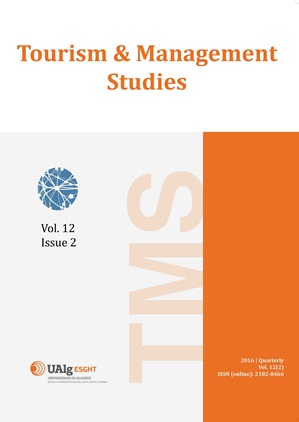Tourist experience in museums: perceptions of managers and visitors
DOI:
https://doi.org/10.18089/Keywords:
Museums, museum marketing, managers’ perceptions, visitor’s perception, visitor’s experience.Abstract
The purpose of this paper is to comprehend differences between museum’s managers perceptions and visitors’ experience. The methodology is qualitative and exploratory comprising three different perspectives: museum’s managers’ directives, visitors’ general opinion (pre experience) and visitors’ post experience. Data were collected through interviews with all the three groups at Belo Horizonte, Minas Gerais, Brazil. Results show that there are incongruences between managers and visitors’ view. Some interviewees highlighted their lack of interest in visiting museums and others affirmed their visit was conditioned to social influence and curiosity. Managers highlighted distinct aspects of museums’ experience: interactivity, visitors’ independence and events schedule. The authors acknowledge the financial support given by Fapemig and Capes.References
Bardin, L. (2008). Análise de conteúdo, 4. ed. Lisboa: Edições 70. Del Chiappa, G., Andreu, L. & Gallarza, M. G. (2014): Emotions and visitors’ satisfaction at a museum. International Journal of Culture, Tourism and Hospitality Research, 8 (4), 420-431.
Doering, Z. (1999). Strangers, Guests, or Clients? Visitor Experiences in Museums. Curator: The Museum Journal. 42 (2), 74-87.
Falk, J. H. & Dierking, L. D. (1992): The Museum Experience. Washington: D.C.Whalesback Books.
Gosling, M., Coelho, M. & Resende, M. P. (2014a). Qualidade percebida e intenções comportamentais de visitantes em museus?: uma proposta de modelo. Revista Turismo Visão e Ação, 16 (3), 656–689.
Gosling, M., Pereira, G. D. A., Vera, L. A. R., Coelho, M. D. F. & Lima, C. G. (2014b). Vamos fazer algo diferente? Um estudo exploratório sobre motivações de visitação a museus. Vianna Sapiens, 5 (2), 336–360.
Goulding, C. (2000). The Museum Environment and the Visitor Experience. European Journal of Marketing, 34 (3/4). 261-278.
Grenier, R. (2010). All work and no play makes for a dull museum visitor. New directions for adult and continuing education, 127, 77-85.
Hiller, M. (2011): Uma experiência Estética e de Marketing em Museus. Acesso em: 30 de junho de 2014 em: http://blogdohiller.blogspot.pt/2012/02/uma-experiencia-estetica-e-de-marketing.html.
Hosany, S. & Witham, M. (2009). Dimensions of cruisers' experiences, satisfaction, and intention to recommend. Journal of Travel Research, 49 (3), 351-364.
Kim, J., Ritchie, B. & McCormick, B. (2012). Development of a Scale to Measure Memorable Tourism Experiences. Journal of Travel Research, 51 (1), 12-25.
Kim, J. & Ritchie, J. R. B. (2014). Cross-cultural validation of a memorable tourism experience scale (MTES). Journal of Travel Research, 53 (3), 323- 335.
Kirchberg, V. & Tröndle, M. (2012).Experiencing Exhibitions: A Review of Studies on Visitor Experiences in Museums. Curator: The Museum Journal, 55 (4), 435-452.
Larsen, S. (2007). Aspects of a psychology of the tourist experience. Scandinavian Journal of Hospitality and Tourism, 7 (1), 7-18.
Lusch, R. F. & Vargo, S. L. (2014). Service-Dominant Logic: Premises, Perspectives, Possibilities. Cambridge, UK : Cambridge University Press.
McLean, F. (1995). A Marketing Revolution in Museums? Journal of Marketing Management, 11, 601-616. McLean, F. (1997). Marketing the Museum. New York: Routledge.
Munar, A. M. & Jacobsen, J. K. S. (2014). Motivations for sharing tourism experiences through social media. Tourism Management, (43), 46–54.
Pezzi, E. (2015). A experiência turística e o turismo de experiência: um estudo sobre as dimensões da experiência memorável. Turismo em Análise, 26 (1), 165-187.
Pine, J. & Gilmore, G. H. (1998). Welcome to the experience economy. Harvard Business Review, 76 (4), 97-105. Pine, B. J. P. & Gilmore, J. H. (2011). The Experience Economy. Boston: Harvard Business Review Press.
Prahalad, C. & Ramaswamy, V. (2004). The future of competition: cocreating unique value with customers. Boston: Harvard Business School Press.
Rentscheller, R. (2002). Museum and Performing Arts Marketing: The Age of Discovery.The Journal of Arts Management, Law, and Society, 32 (1), 7-14.
Schmitt, B. H. (1999). Experiential Marketing: How to Get Customers to Sense, Feel, Think, Act, Relate to Your Company and Brands. New York: The Free Press.
Schmitt, B. (2000): Marketing experimental. São Paulo: Nobel. Shaw, C. & Ivens, J. (2002). Building Great Customer Experiences. New York: Palgrave Macmillan.
Sheng, C-W. & Chen, M-C. (2012). A study of experience expectations of museum visitors. Tourism Management, 33 (1), pp. 53-60.
Silva, P. & Santos, G. (2011). A qualidade da experiência dos visitantes ao Museu do Futebol. Observatório de Inovação do Turismo - Revista Acadêmica, 6 (2), 1-19.
Soares, C. T. S. (2010). O processo de significação da experiência museal: um estudo sobre o contexto pessoal dos professores de Ciências. Dissertação: Mestrado em Educação – PUC, Porto Alegre.
Thyne, M. (2000). The Importance of values research for nonprofit organisations: The motivation-based values of museum visitors.International Journal of Nonprofit and Voluntary Sector Marketing, 6 (2), 116-130.
Thyne, M.; Hede, A. M. &White, T. (2009). Co-constructing the museum visitors’ experience: a case of two literary museums. Proceedings of 'Sustainable Management and Marketing', 23rd Annual Australian and New Zealand Marketing Academy Conference (ANZMAC), Melbourne, Victoria, Australia.
Weil, W. E. (2000). Transformed form a cemetery of bric-a-brac. In: Sheppard, B. (Ed.), Perspectives on outcome based evaluation for libraries and museums. Washington, D.C.: Institute of Museum and Library Services.
Downloads
Published
Issue
Section
License
Copyright (c) 2016 Tourism & Management Studies

This work is licensed under a Creative Commons Attribution-NoDerivatives 4.0 International License.
The journal retains published articles’ copyrights, but they are simultaneously licensed under the Creative Commons Attribution License (CC BY-NC-ND), which allows individuals’ to share the relevant papers as long as authorship and publication in this journal are duly acknowledged.



